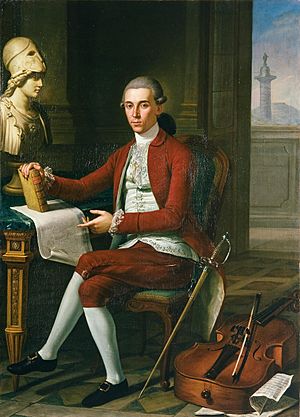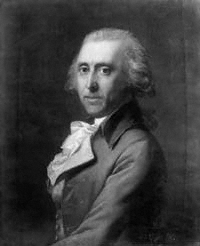Sir James Lamb, 1st Baronet facts for kids

Sir James Bland Lamb, 1st Baronet (born James Burges on June 8, 1752 – died October 13, 1824) was an important person in British history. He was a writer, a lawyer, and a Member of Parliament. From 1795 to 1821, he was known as Sir James Burges, Bt.
Contents
Who Was Sir James Bland Lamb?
Early Life and Education
James Burges was the only son of George Burges and Anne Whichnour Somerville. His mother was the daughter of James Somerville, 12th Lord Somerville. His father was a brave soldier who captured a flag at the Battle of Culloden. He later worked as a paymaster in Gibraltar.
James went to Westminster School, a famous school in London. In 1770, he started studying at University College, Oxford. Later, in 1773, he studied law at Lincoln's Inn, which is a place where lawyers are trained.
His Career in Politics
James Burges first became a Member of Parliament for Helston. He served in this role from 1787 to 1790.
After that, he worked as an Under-Secretary of State for Foreign Affairs from 1789 to 1795. This meant he helped with Britain's relationships with other countries. On October 21, 1795, he was given the title of baronet, which is a special honor. In November of the same year, he became the knight marshal of the king's household. In this role, he had an important part in the coronation ceremony of King George IV.
Sir James as a Writer and Poet
His Passion for Writing
Sir James Burges loved to write and was very good at it. He was friends with famous writers like William Cumberland and John Graves Simcoe. He also supported younger writers, like Thomas Dermody. He was even connected to the famous poet Lord Byron through marriage.
He wrote music for a poem called "Ode to the Passions" by William Collins. He also wrote the introduction for a play called Vortigern and Rowena in 1796.
His Published Works
Sir James wrote many long poems. One of his poems, The Birth and Triumph of Love, was published in 1796. It was a very long poem, with 16,000 lines! However, it was not very popular. Despite this, Sir James still had enough money and respect to keep writing.
He wrote an introduction for a fake Shakespeare play created by William Henry Ireland. He also had a play performed at the Drury Lane theatre. Even though Lord Byron liked his work, no other plays by Sir James were performed after that.
He also wrote an introduction for a later version of the book Pilgrim's Progress sequel, called Progress of the Pilgrim Good-Intent in Jacobinical Times. In this introduction, he shared that his talented sister, Mary Ann Burges, was the real author of the book.
Sir James's Family Life
His Marriages and Children
Sir James Burges was married three times. His first marriage was in 1777 to Elizabeth Noel. She was the daughter of Edward Noel, 1st Viscount Wentworth. They did not have any children.
His second marriage was to Anne, the daughter of Lieutenant-Colonel Louis Charles Montolieu. They had several children:
- Charles Montolieu (1785–1864), who became the 2nd Baronet.
- Wentworth Noel (born December 30, 1792). He was an ensign (a junior officer) in the Coldstream Guards. Sadly, he was killed in 1812 during the Siege of Burgos in the Peninsular War.
- Somerville Waldemar (born March 7, 1794). He was also an ensign in the 1st Foot Guards. He lost a leg at the Battle of Waterloo in 1815. In 1821, he married Mademoiselle Melanie-Marianne Meray.
- Clara Maria (died February 4, 1821).
- Emilia Charlotte, who married Major-General Sir Hugh Halkett on May 25, 1810.
- Caroline Eliza Anne (died November 20, 1863).
- Sophia Anne (died October 11, 1858), who married Warburton Davies on December 21, 1821.
- Julia Octavia (died October 28, 1826).
In 1812, he married for the third time to Lady Margaret Fordyce. She was the widow of Alexander Fordyce and the daughter of James Lindsay, 5th Earl of Balcarres. They did not have any children together.
On October 25, 1821, his name was officially changed to James Bland Lamb by a special Royal Licence.
What Did Sir James Bland Lamb Write?
Here are some of the books and poems Sir James Bland Lamb wrote:
- Heroic epistle from Serjeant Bradshaw to John Dunning. (1780)
- Considerations on the law of insolvency. (1783)
- A letter to the Earl of Effingham. (1783)
- Address to the country gentlemen of England. (1789)
- Letters on the Spanish aggression at Nootka. (1790)
- Narrative of the negotiation between France and Spain in 1790. (1790)
- Alfred's letters: a review of the political state of Europe. (1792)
- The birth and triumph of love. (1796)
- Richard the first: a poem in eighteen books. (2 volumes, 1801)
- The exodiad (with Richard Cumberland). (1807, 1808)
- Riches, or the wife and brother: a play. (1810)
- Songs, duets, etc. in Tricks upon travellers, a comic opera. (1810)
- Dramas. (2 volumes, 1817)
- The dragon knight: a poem in twelve cantos. (1818)
- Reasons in favour of a new translation of the holy scriptures. (1819)
- An inquiry into the procrastination attributed to the House of Lords. (1824)
- Selections from the letters and correspondence, edited by Hutton. (1885)


